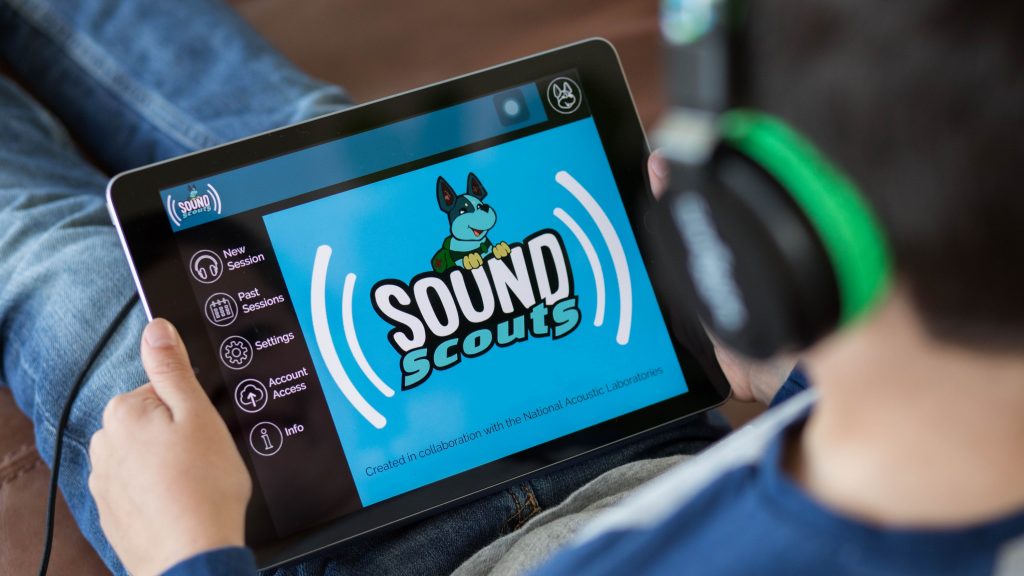Touch screen app detects childhood hearing loss
Up to 3.6 million Australians are living with problems related to
hearing loss, some of which may have been prevented if it had been caught early
on. Undiagnosed hearing impairment also has serious effects on children’s
ability to learn, undermining their prospects in future life.
While hearing tests in newborns are good at picking up congenital
impairments, many children develop problems in their first five years, which
may not be detected before they enter school.
Until recently in Australia, many of these children would have
struggled through the school system, having trouble listening and paying
attention, and potentially being wrongly diagnosed with conditions such as
attention deficit disorder (ADD).

But now a user-friendly hearing test, cleverly embedded in a tablet
and smartphone game called Sound Scouts, has been taken up
by the federal government and is being rolled out to 600,000 Australian
children over the next four or more years.
Fun, cheap and easy to administer
The $4 million initiative, announced in November 2018, was the result
of eight years of research, development and lobbying by the Sydney-based Sound
Scouts team. CEO and founder, Carolyn Mee, says she has long been interested in
using the power of games and apps to solve health issues.
“Embedding the test in a game serves a couple of purposes,” she says.
Aside from being fun, cheap and easy to administer, “it engages the child so
they stay focused – they’re invested and ideally the quality of data should be
of a high quality.”
Traditional audiology tests, which only check a child’s hearing in
quiet conditions, can fail to detect specific types of listening difficulties that
are only noticeable when there’s background noise. These difficulties can be
caused by language and attention issues or a problem with processing auditory
information in the brain. Children with these problems can struggle to hear or
to understand information delivered verbally in a classroom.
But many other children also develop hearing loss in their first five
years of life, due to factors such as middle ear infections or glue ear, and
may begin school without the problem being diagnosed.
Mee, who had previously worked in television as a producer, director, and a kids television presenter, became interested in the health applications of games after winning a government scholarship to study new media in 2010. The same year, there was a senate inquiry into hearing health in Australia, which recommended universal screening for school-age kids.
Worrying level of hearing loss in Aboriginal children
Mee was further motivated by the disturbing level of hearing problems
in Aboriginal communities, some of which are caused by recurrent ear infections.
Only 4% of Australian children are Aboriginal and yet they represent 9% of
those fitted with hearing aids – a problem further exacerbated by the lack
of access to audiologists in remote areas of Australia, where many of these
children live.
“Hearing about all the challenges in that space really inspired me,”
Mee adds.
Working with creative coder and game designer Cuauh Moreno and the former Director of the National Acoustic Laboratories, Professor Harvey Dillon, the game was developed, perfected and commercialised over the following eight years.
Sound Scouts involves a number of game-based activities, which
children play by responding to a series of audio cues. It tests for three types
of hearing and auditory processing problems: sensorineural hearing loss, caused
by damage to the inner ear or nerves; conductive hearing loss, whereby sounds
fail to pass into the inner ear; and a type of auditory processing disorder
that can make it difficult to understand speech when there’s background
noise.
It is effective at detecting hearing loss in 85% of children who
suffer from it.
The federal government’s adoption of Sound Scouts was the result of
years of campaigning and lobbying ministers. Following the 2010 senate inquiry,
universal school entry hearing tests were considered, Mee says, “but barriers
included cost and finding a scalable solution to test the hearing of
approximately 310,000 children that start school each year. To test that number
of children with an audiologist was prohibitive”.
Great benefits to children and communities
By the time a second senate inquiry on hearing health was completed in 2017, Sound Scouts had benefitted from a $1.1 million grant from the NSW Government’s Medical Devices Fund to further its development. An evaluation by Macquarie University had also revealed that Sound Scouts was cost effective, finding that for every $1 spent on the app, it would deliver $10 worth of benefit to children and their communities.
“All of this groundwork added up to a product that was the obvious
solution to address that recommendation for school entry screening,” Mee
says.
Seeing the test rolled out to more than half a million children is a
wonderful prospect. “We’d always hoped it would be a subsidised test, freely
available to all Australian children. We’ve worked towards this for eight
years, and it’s obviously incredibly fulfilling to see that play out.”
International versions of Sound Scouts may be launched in the UK, US
and Mexico in the next year, with China also on the radar, where hearing
impairment is one of the most common disabilities.
By John Pickrell
Related links
Sound Scouts accessible hearing test
Professor
Dillon, Senior Research Scientist at the National Acoustic Laboratories
2010 Senate inquiry – Hear Us: Inquiry into Hearing Health in Australia
Updated 3 months ago